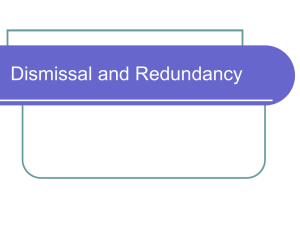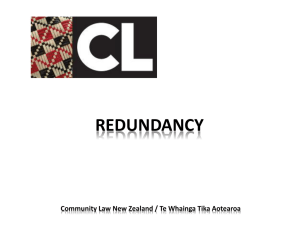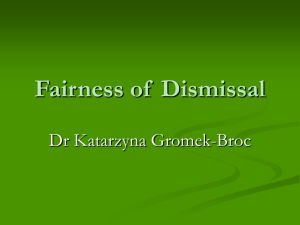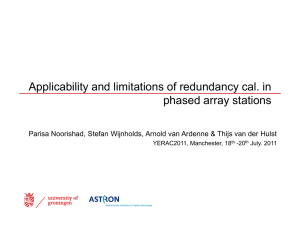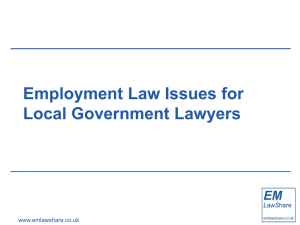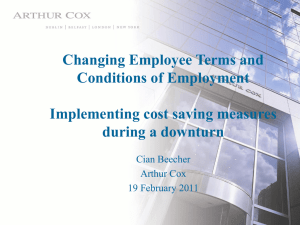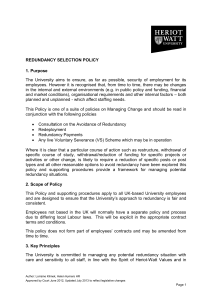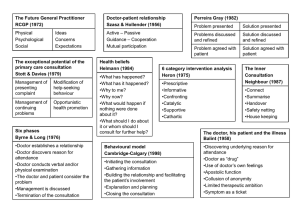what is a redundancy?
advertisement
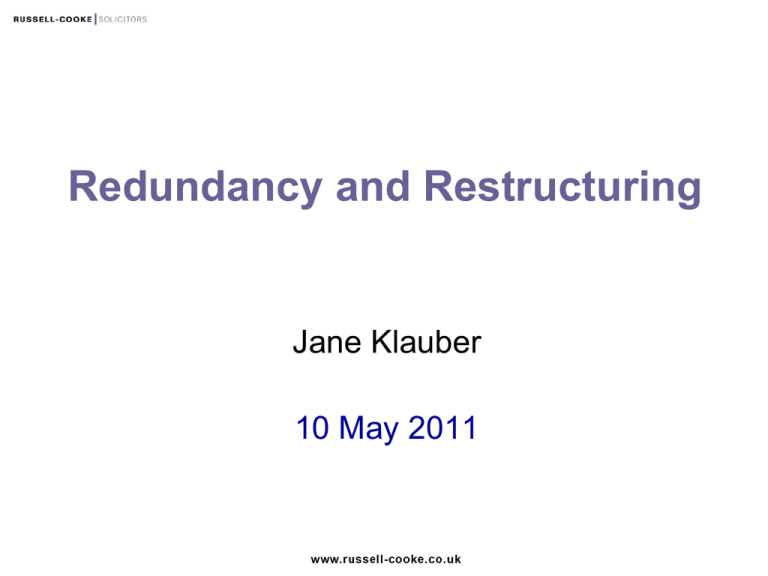
Redundancy and Restructuring Jane Klauber 10 May 2011 ALTERNATIVES TO REDUNDANCY Natural wastage Let agency staff go Cut back/freeze recruitment Reduce/eliminate overtime Lay off/short-time working Consider offering voluntary redundancy VARYING A STAFF CONTRACT Alternatives to redundancies: Temporary pay freeze Reduction in hours Reduction in pay By informed and express consent By express variation clause but any unreasonable change may constitute a breach of trust and confidence By serving notice and offering a new contract following consultation But unilateral imposition without a variation clause will amount to unfair dismissal as well as breach of contract MOBILITY CLAUSES The “factual” rather than “contractual” test will apply Commonly employers will offer redundancy where significant relocation is required The employee will not be entitled to a redundancy payment if the transfer to a new workplace constitutes suitable alternative employment which he unreasonably refuses BUSINESS REORGANISATION The dismissal of an employee who refuses to agree contractual changes may be fair if the employer has a sound good business reason The employer must evidence the advantages of the changes. Profitability alone is unlikely to be sufficient WHAT IS A REDUNDANCY? SECTION 139(1)(B) EMPLOYMENT RIGHTS ACT 1996 (ERA 1996) – STATUTORY DEFINITION OF REDUNDANCY An employee’s dismissal must be wholly or mainly attributable to the employer: Ceasing or intending to cease to carry on the business for the purposes of which the employee was employed by it (business closure) Ceasing or intending to cease to carry on that business in the place where the employee was so employed (workplace closure); or Having a reduced requirement for employees to carry out work of a particular kind or to carry out work of a particular kind at the place where the employee was employed to work (headcount reduction) UNFAIR DISMISSAL FAIR REASON Employees with over one year of service have the right not to be unfairly dismissed (section 94, ERA 1996) Redundancy is a potentially fair reason for dismissal (section 98, ERA 1996) Automatically unfair redundancies (section 105, ERA 1996) Even where there is a genuine redundancy situation, an employer will need to ensure that they follow a fair process (section 98(4) ERA 1996) EXAMPLES OF REDUNDANCY Reallocation of duties Change to the kind of work Re-organisation leading to a reduced need for employees NOT REDUNDANCY Appointment of a junior employee to do the same work Change in an individual’s role if the requirement for employees to do work of a particular kind has not diminished FAIR PROCEDURE (1) Procedural fairness is essential to avoid an unfair dismissal claim Polkey – failure to follow correct procedures likely to render dismissal unfair unless doing so “utterly useless” or “futile” Question of whether employee would have been dismissed anyway only relevant to compensation FAIR PROCEDURE (2) The “Williams Guidelines” warn and consult employees about possible redundancies; adopt a fair basis of selection; take reasonable steps to minimise the number of redundancies by considering alternative work. FAIR PROCEDURE (3) Union agreement Contractual provisions Handbook FAIR PROCEDURE (4) Adequate warning Fair selection: correct pool and objective criteria Consultation Suitable Alternative Employment IDENTIFYING THE POOL May be agreed with union or employee reps The jobs may be similar or interchangeable Ensure there are no jobs outside the identified pool which are the same/interchangeable SELECTION CRITERIA Must be reasonable Non-discriminatory (direct or indirect discrimination) Performance and ability (must be evidenced) Disciplinary record Attendance (exclude DDA and maternity absence) LIFO Bumping FORMAL NOTIFICATION Notification post at risk Confirm selection criteria Invitation to volunteer Consultation to be followed Any redeployment opportunities Redundancy entitlement INDIVIDUAL CONSULTATION (1) Reasonable period Genuine engagement Documented Confirm basis of selection and allow employees to comment on individual assessment Allow employees to make suggestions to avoid redundancy Consideration of alternative employment INDIVIDUAL CONSULTATION (2) Consultation should commence while proposals are still being formulated No prescribed period but 7 days is the “bare minimum” A failure to consult may render a dismissal unfair COLLECTIVE CONSULTATION Proposal to dismiss 20 or more at one establishment within 90 days 20-99 30 days consultation 100+ at least 90 days Consultation with TU reps or reps appointed or elected who have authority to receive information and be consulted Also applies to varying terms and conditions where the employer has to terminate employment and re-engage ELECTION REQUIREMENTS The employer must: make arrangements to ensure the election is fair determine the number of representatives to ensure all groups of employees are represented determine whether employees should be represented by reps of particular groups decide term of office all affected employees are entitled to vote voting must be in secret and votes accurately counted COLLECTIVE COSULTATION Representatives must be provided with written information including: the reasons for the proposed redundancies; the number and description of employees proposed as redundant; total number of employees of that description employed at the establishment; proposed method of selection; proposed method and timescale for carrying out dismissal; and Method of calculating any non statutory payment. COLLECTIVE CONSULTATION Consultation should include the reasons in a closure case Consultation must conclude before the first notice is issued The rules apply even if fewer than 20 are made redundant COLLECTIVE CONSULTATION Consultation must be in good faith with a view to reaching agreement on avoiding dismissals reducing the number of dismissals Mitigating the consequences of dismissals COLLECTIVE CONSULTATION (5) Protective awards of up to 90 days pay for failure to consult or comply with election requirements SUITABLE ALTERNATIVE EMPLOYMENT No obligation to create a new role But any vacancy should be offered even if not considered suitable Evidence will be required as to why a role is not suitable Trial period (4 weeks) may be extended for retraining If the employee unreasonably refuses he will lose redundancy entitlement Consider selection process if more than one employee is eligible Remember any employee on maternity leave has priority for redeployment Avoid “slotting in” and “matching” JDs. ENTITLEMENTS STATUTORY REDUNDANCY PAY Employees with at least two years of service are entitled to a statutory redundancy payment (section 135, ERA 1996). Only employees are entitled to statutory redundancy payments Statutory redundancy pay calculated by reference to an employee’s age, length of service and weekly pay capped at £400 from 1 February Maximum length of service to be taken into account = 20 years (section 162(3), ERA 1996). An employee may lose their right to a redundancy payment where either an incident of gross misconduct comes to light during redundancy consultation, or the employee is guilty of gross misconduct during their notice period ENHANCED REDUNDANCY PAY Is it required by contract/policy Is it the best use of the charity’s resource? NB any enhancement may be caught by age discrimination rules TAX TREATMENT Statutory payments are tax free Termination payments are tax free up to £30k (including the statutory element) If a PILON is made it will be safest to deduct tax or (if relying on payment as damages for breach of contract) terminate contract before payment is made TOP TIPS FOR MINIMISING LEGAL RISK Need for clear business reason for redundancies – should be documented Take care in considering appropriate selection criteria Managers should be trained to ensure that objective selection criteria are fairly applied Suitable alternative employment should be considered widely Remember to consult long term sick and employees on maternity leave Ensure there is someone available to respond to any queries employees may have Consider offering a compromise agreement TUPE Application of Tupe Same rules regarding election of representatives as for collective redundancy Duty to inform representatives of - transfer - date of transfer - reason for transfer - legal, social and economic implications - any measures Consultation on measures Protective awards TUPE Any dismissal or contractual change which is transferrelated will be automatically unfair Unless there is an “ETO” reason requiring a change to the number or functions of staff A transferor will not be able to rely on a transferee’s defence An ETO reason may only apply to a section of the workforce An employee may object to transfer If objection is on the basis of a substantial change in working conditions he may treat himself as having been dismissed and the dismissal will be unfair INSOLVENCY Where insolvency proceedings are instituted with a view to liquidating the Transferors assets, employees do not transfer and there is no protection against contractual variations or dismissals connected to the transfer Where insolvency proceedings are not commenced with a view to liquidating assets, contractual variations may be agreed with employee representatives in order to safeguard employment CONTACT DETAILS Jane Klauber E: jane.klauber@russell-cooke.co.uk T: 020 8394 6483

